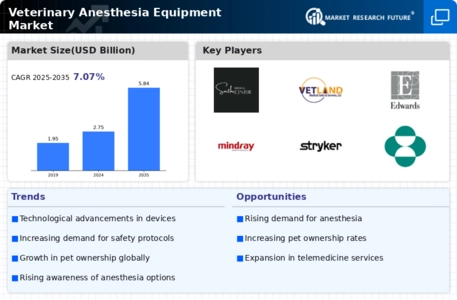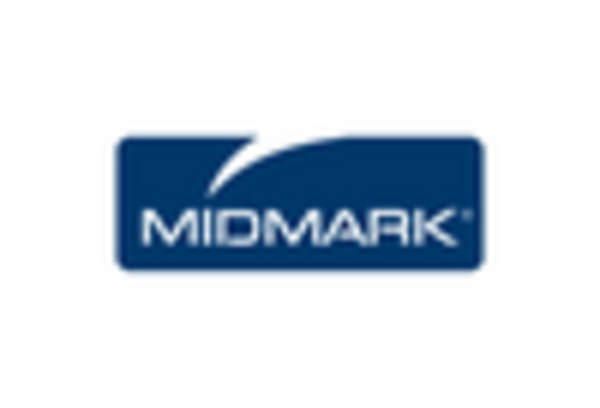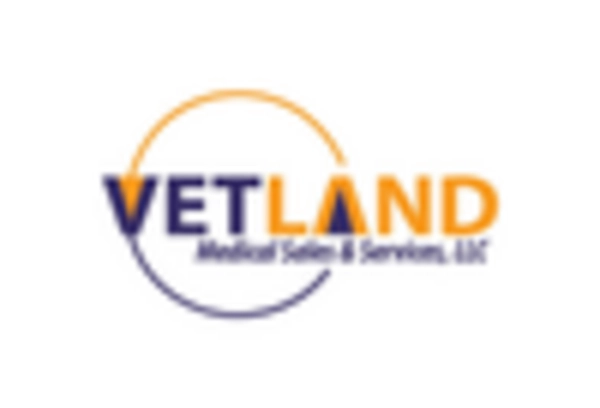Increased Focus on Animal Welfare
The Veterinary Anesthesia Equipment Market is significantly influenced by the growing emphasis on animal welfare. Pet owners and veterinary professionals are becoming more aware of the importance of humane treatment during surgical procedures, which necessitates the use of high-quality anesthesia equipment. This heightened awareness is leading to increased investments in advanced anesthesia technologies that ensure the comfort and safety of animals. According to recent data, the market for veterinary anesthesia equipment is expected to reach USD 1.5 billion by 2026, reflecting a shift towards more ethical practices in veterinary medicine. As a result, the demand for reliable and effective anesthesia solutions is likely to surge, further propelling the growth of the Veterinary Anesthesia Equipment Market.
Rising Number of Veterinary Practices
The Veterinary Anesthesia Equipment Market is benefiting from the rising number of veterinary practices worldwide. As the pet population continues to grow, there is a corresponding increase in the demand for veterinary services, including surgical procedures that require anesthesia. This trend is particularly evident in emerging markets, where the establishment of new veterinary clinics is on the rise. The expansion of veterinary practices is likely to drive the demand for anesthesia equipment, as these facilities seek to provide comprehensive surgical services. Market analysis suggests that the number of veterinary clinics could increase by 10% annually in certain regions, further stimulating the Veterinary Anesthesia Equipment Market. This growth presents opportunities for manufacturers to introduce innovative products tailored to the needs of these expanding practices.
Regulatory Compliance and Safety Standards
The Veterinary Anesthesia Equipment Market is also shaped by stringent regulatory compliance and safety standards. Regulatory bodies are increasingly mandating that veterinary practices adhere to specific guidelines regarding anesthesia administration, which necessitates the use of certified equipment. This trend is driving veterinary clinics to invest in high-quality anesthesia machines and monitoring devices that meet these regulatory requirements. As a consequence, the market is witnessing a shift towards more reliable and safer anesthesia solutions. The implementation of these standards is expected to enhance the overall quality of veterinary care, thereby fostering growth in the Veterinary Anesthesia Equipment Market. The anticipated increase in compliance-related investments could lead to a market expansion valued at over USD 1.2 billion by 2025.
Growing Pet Ownership and Veterinary Services
The Veterinary Anesthesia Equipment Market is experiencing growth due to the increasing rates of pet ownership and the corresponding rise in veterinary services. As more households adopt pets, the demand for veterinary care, including surgical interventions, is escalating. This trend is particularly pronounced in urban areas, where pet ownership rates have surged. Consequently, veterinary clinics are expanding their service offerings, which includes the need for advanced anesthesia equipment to ensure safe and effective procedures. Recent statistics indicate that the pet care market is projected to grow by 8% annually, which is likely to drive further investments in veterinary anesthesia technologies. This growing demand for veterinary services is expected to significantly contribute to the expansion of the Veterinary Anesthesia Equipment Market.
Technological Advancements in Veterinary Anesthesia Equipment
The Veterinary Anesthesia Equipment Market is experiencing a notable transformation due to rapid technological advancements. Innovations such as advanced monitoring systems, automated anesthesia delivery devices, and improved gas scavenging systems are enhancing the safety and efficacy of anesthesia in veterinary practices. For instance, the integration of real-time monitoring technologies allows veterinarians to track vital signs more accurately, thereby reducing the risk of complications during procedures. Furthermore, the market is projected to grow at a compound annual growth rate of approximately 6% over the next few years, driven by these technological improvements. As veterinary practices increasingly adopt these advanced tools, the demand for sophisticated anesthesia equipment is likely to rise, indicating a robust growth trajectory for the Veterinary Anesthesia Equipment Market.

















Leave a Comment